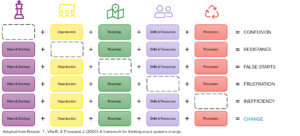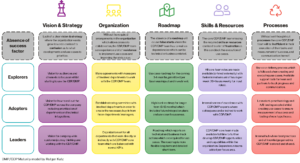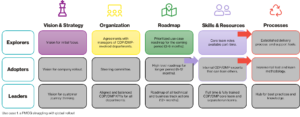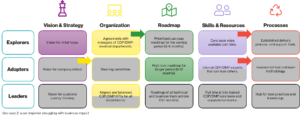Five Success Factors for Implementation of DMPs and CDPs
October 23, 2018Data Management Platforms (DMP) and Customer Data Platforms (CDP) are both technologies that have the potential to uproot the internal organization due to their cross-departmental function. Both technologies enable a link between online and offline customer information and allow marketeers to track, automate and orchestrate large parts of a customer journey. This requires that online (e.g. social media) teams have to collaborate with offline (e.g. CRM) teams. Mature companies would have cross-departmental and multidisciplinary teams that focus on key aspects of the customer journey such as sales funnel conversion optimization. Unfortunately, there are still many organizations either in their digital transformation or have not started it yet to such an extent that it can sustain such teams. Because the DMPs and CDPs are such disruptors of the organization, companies should start a transformation program to facilitate the transition that enables cross departmental and multidisciplinary teams. An important starting point is to create a strategic vision of initial focus areas and ultimately a total transformation goal for the entire company. To assist companies in establishing a strategy and adoption of these technologies we wanted to create a maturity model which could also be used as a benchmark in a company’s growth towards being a CDP/DMP enabled organization.

Click to download larger image
A pinch of old with a dash of new
To structure this maturity model we used the model of M. Lippit from 1987 for successful business change. M. Lippit’s model was focused purely on project management for the successful implementation using five success factors. However, when focusing on the maturity of an organization we should also look at the maturity of each of those success factors. It is through the combination of M. Lippit’s success factors, including a slight adjustment, with our proprietary maturity levels, that we could create a maturity model that fits extremely well with the issues we experienced in companies struggling with gaining value out of their CDP/DMP.
The maturity model consists of three maturity levels, Explorers, Adopters and Leaders, each with their own goals over each of the five success factors of M. Lippit’s model: 1. Vision & Strategy | 2. Organization | 3. Roadmap | 4. Resources & Skills | 5. Processes.
Getting a running start and growing from there
Organizations that are exploring or have just acquired a DMP or CDP would do well to start with creating a Vision & Strategy and establish a core team (including all the necessary roles) if they are not already available. Make use of the platform suppliers or external expert consultants to assist in establishing these goals as they are of high importance for a running start. The next priorities are ensuring that the initial roadmap is impactful and is aligned with IT should their assistance be required for any integrations. Again the supplier should be able to provide a shortlist of easy to implement use cases and customize them to your business. At this point the business and IT management agreements come around in order to facilitate the core team to be able to work on the platform. The core team should establish a delivery process (e.g. Scrum) and pick a selection of productivity tools (e.g. Jira) which works well for them and the organization. Now the organization should have its Explorer goals reached and can start creating value out of the platform while the entire organization learns what it is to work with a DMP/CDP.


Click to download larger image
In our maturity model the entire organization grows along while each goal has been accomplished. The achievements of earlier goals, when communicated widely enough in the organization, will release a ripple effect through the departments and colleagues to facilitate the changes in behavior and thought that make it easier to complete higher level goals. For example, it will be difficult creating a set of aligned CDP/DMP related KPI’s (a Leader goal) in most organizations without first getting agreements with the managers (an Explorer goal) and establishing a steering committee which influences priorities for each business unit’s resource (an Adopters goal). The managers first need time to see the value of the platform and realize that in order to motivate colleagues from different departments to collaborate on a CDP/DMP, they should also have KPI’s that focus on that cross departmental work.
As companies grow along their maturity they will realize that the earlier level goals have been the stepping stones that to pave the way for the higher level goals. The time required to progress from an organization without any of the goals to a fully mature DMP/CDP enabled organization differs per organization and situation, but on average would be 2-3 years. Using two real life examples we will demonstrate the worth of using our maturity model in overcoming roadblocks related to the absence of achieving success factor goals and that the sequence of the goals is of importance.
Case 1: Creating your internal experts and processes
The first case was at a FMCG organization that implemented a DMP one year ago and was working on their vision of a global rollout of the product (Explorers goal in Vision, working on Adopters goal). They had made management agreements (Explorers goal in Organization), a shortlist of easy to implement use cases that could be done in each country (Explorers goal in Roadmap) and a core-team which worked on the DMP part-time (Explorer goal in Skills & Resources) without any real structure in their approach (no Explorers goal in Processes). However, due to a lack of skillsets and knowledge abroad they hit a wall trying to establish the DMP in new markets. The local team and agencies did not know where to start and the global team had just enough knowledge on how the tool works, but not enough maturity to guide other local teams.
We decided to train the global team to be experts in the tool and the guiding light for the rest of the organization. After a large set of in-depth training days to create our center of excellence (Adopters goal in Skills & Resource) we went to work with the global team to establish standard and structured delivery processes explaining the entire process (Explorers goal in Processes) of a use case from idea to measuring it’s success (Adopters goal in Processes). Furthermore we created a standard country rollout plan that they could use for each new country that would be onboarded on the platform. From then on each country could use the delivery process to get a running start and contact the global expert team to resolve questions and issues.

Click to download larger image
Case 2: Too fast for your own good
The second case was at a large car importer for multiple brands that had a very strong strategy of where the company should go in terms of customer experience the next few years (Explorers and Adopters goal in Vision & Strategy), complete with a high level roadmap of the next three years (Adopters goal in Roadmap). The company also had a core team with full time members that was able to establish use cases (Explorers goal in Skills & Resources, advancing into Adopters goal). Furthermore, they had some agreements with the different car brands to work on the DMP platform and was implementing KPI’s for every department to spend at least a few hours a week on the DMP after convincing senior management that this was the way to go (Explorers and Leaders goal in Organization).
However, most colleagues and managers from other departments had no idea what they should do to achieve their DMP KPI’s or even what a DMP was. The KPI’s were only vaguely formulated as a 10% time spent on DMP activities requirement. Furthermore, the use cases that they executed were small in impact due to a lack of certain technical integrations (e.g. CRM integration with a weekly change upload) and not prioritizing higher impact use cases. And because the impact of these use cases weren’t communicated, the brands had no way of knowing how the DMP platform could influence their core business.
In short, the company had already gone ahead and reached some higher level goals on some success factors while ignoring intermediate and beginning steps on others. To reground the organization we first took care of all the basics, getting the technical integrations in order which were crucial for some easy high impact use cases. We created a short term roadmap with technical integrations and use cases that build on them (Explorers goal in Roadmap). We also started to include the impact measuring of use cases and sharing of successes as a step in the standard process in order to spread the word of what a DMP can do to inform other departments of our capabilities (Explorers and Adopters in Processes).

Click to download larger image
Not a one trick pony!
Organizations should not underestimate the amount of coordination and effort it takes to successfully implement a DMP/CDP. Unfortunately, it also takes time. Colleagues and managers from different departments have to experience the success of the platform before they are convinced to want to try it themselves, before committing fully. This is exactly why it is important to follow the sequence of the maturity model, to let the earlier level goals pave the road in order to achieve the next ones effectively. Using our maturity model, organizations can either prepare for an implementation by strategizing when to accomplish which goal or use it to further their implementation using our achievable goals in order to increase the impact the DMP/CDP has on their daily business.
The model has been made specific to DMP/CDP implementations, but it can also be adapted to different technology and platform implementations into organizations. I have used it for data science maturity within organizations and plan to use it for Robotic Process Automation. If you are struggling with such an implementation yourself and you could use my insights or clarification on the model, feel free to reach out to me through Linkedin. I would also love to hear your thoughts and experiences in the comments below.


